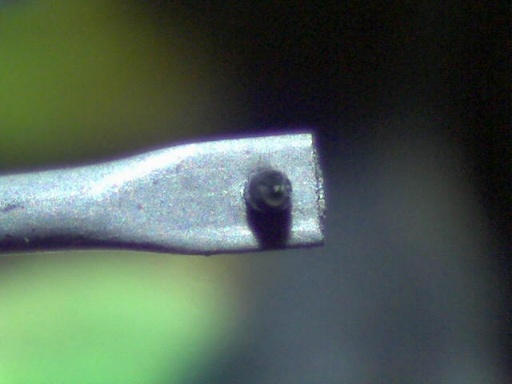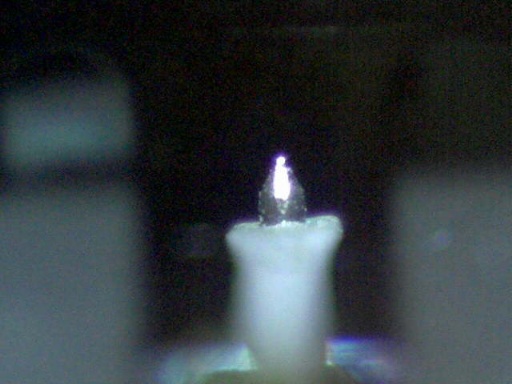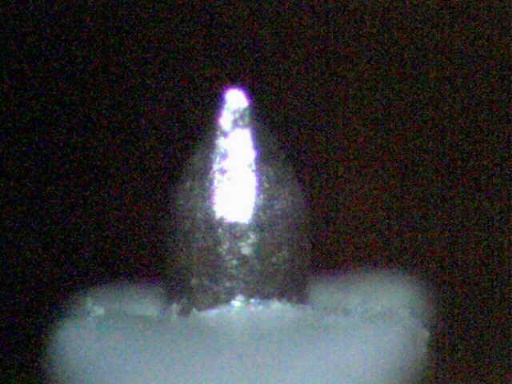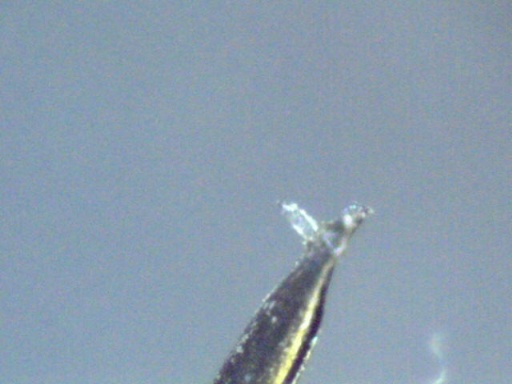[ TNT | Who we are | HiFi Shows | Factory tours | Listening tests | HiFi topics | Tweakings | Inter.Views ]
Shure M97xE cartridge
How low can you go?
![[Shure M97xE cartridge]](../jpg/shure_m97xe_t.jpg) [Italian version]
[Italian version]
Product: M97xE MM stereo cartridge
Manufacturer: Shure - USA
Price: from € 80, $ 70
Reviewer: Werner Ogiers - TNT Belgium
Reviewed: June, 2007
|
Erratum (February 2010)
Much to my shame my original text contained an important error. It read that the Shure M97xE body is compatible with the VN5MR replacement stylus, while in reality it is the VN5xMR stylus (the VN5MR does not fit the body, not at all!). This was a stupid typo, after all I once had the VN5xMR in my hands, and this was recently pointed out by a somewhat angered reader.
The reason it took the best of three years to discover this error probably lies in its irrelevance, due to Shure's discontinuation of these V15V*MR cartridge replacement styli. This rendered my sin quite harmless.
But not so anymore: JICO of Japan has taken it upon them to manufacture after-market styli for the V15VMR, its derivatives like the Ultra 500, and V15VxMR cartridges. Prices start at a very low $107 for a standard elliptical stylus, and rise to a still very low $122 for the fineline SAS stylus on a boron cantilever and with a rare earth magnet.
What's more, there even is an upgrade SAS stylus assembly for the M97xE proper, so there is no longer any need to adopt the VN5xMR with its slightly suboptimal magnetic circuit (optimal for the V15VxMR generator, not for the M97xE). This offers a great opportunity for many owners of these Shure cartridges, assuming that JICO's quality control betters Shure's, of course...
Once more my apologies to anyone harmed by my mistake, and I hope this addendum redresses this somewhat.
|
Until the demise of the legendary V15 series the M97xE was Shure's second cartridge from the top. Now it is their top. And while it lists for around 120 euros in stores, these cartridges are sold over the internet and at DJ/pro-audio outlets for prices as low as $70 in the USA and €80 in the old world*.
Attractive?
![[Shure M97xE phono cartridge]](../jpg/shure_m97xe_2_t.jpg)
Despite its silly low cost the M97 comes in a mightily impressive package. There's the oversized metal box, containing the cartridge proper as well as all mounting hardware, a screwdriver, a cleaning brush, and even a cardboard two-point alignment protractor with null points at 66 and 121 mm (its center hole was off by at least one millimeter, this of little importance as it only grows tracing distortion with 0.02%).
The cartridge itself looks like the V15's twin brother, the only visible difference being the colour scheme. Being a classic 'true' moving magnet coil inductance and resistance are high at 650 mH and 1550 Ohms, the output is a useful 4.0 mV into 47kOhms and 200-300pF (not too low - noise! - like the 1.6mV Denons, not too high - overload! - like the 7.0mV Regas).
Visual inspection reveals the cartridge to be built to pretty high standards. Cantilever and stylus look good, and the removeable stylus assembly has a tight fit into the housing itself, making the flat-earth practice of super-glueing it quite redundant here.
Classically-Shure is the presence of an integrated stylus guard + damping brush. When employed this pre-swipes dust from the groove (not in my house!), channels off static charges, and damps warp-induced vertical motion. The latter feature also helps cartridge-arm compatibility, as it allows this compliant MM to ride safely in the medium-to-high-mass arms found on older turntables.
A drawback of its construction, however, is that the M97 (just as the V15), looks 'busy', like a collection of small funny parts, with little visual appeal. In other words: it is darn ugly and likely to disfigure any turntable (which are, after all, often objects of beauty).
The joy induced by this Shure's low price and copious packaging evaporates quickly while mounting it into a tonearm. Without threaded mounting holes and a near-total lack of straight edges this cartridge is an utter pain to line up. I persevered, and after two lengthy (and back-breaking) sessions I got it into a Rega RB-300, aligned with the method outlined in my Schon review.
|
Taking Measures
Using the Hi-Fi News test record pink noise tracks I recorded the M97xE's frequency response versus load capacitance. The manufacturer claims 20Hz-22kHz, but reality showed a severly down-tilted response, surprisingly devoid of any treble peaking.


Shure recommend 200-300pF of total capacitive loading, and this is spot-on with 250pF giving the most balanced frequency results below 15kHz. (I did the listening with my Dino's 220pF, close enough.) Any C value deviating much from this optimum will result in compromised sound, though.


The next graph is crosstalk. Shure specifies 25dB, but the first test sample failed even to attain 18dB, which is a very bad result, I'll reveal the origin of this later on. Luckily a second sample did better, if not quite meeting its spec with 21dB and 24dB (note that the very same test record measures 40dB with my Jan Allaerts MC1b; also note that the spikes in the graphs find their origin in the test record used and/or the arm, to be investigated.)

Shures traditionally used to have a very high compliance, favouring tracking, but not so the M97xE which is in line with 21sth-century MM practice. With the front damping device disabled the resonant peak in my modifed RB-300 arm was at 10Hz and pretty peaky. This would preclude the use of this cartridge in the heavier arms of older turntables, as is the case with most other MMs too, but lo!, click down the damper and the peak is totally flattened, indicating more stable tracing as well. This then makes the M97xE nearly-universal in its arm compatibility. The damper brush may look ugly, but effective it is!
Tracking then. I lost my notes and measurement files, shame on me, but I seem to remember that tracking was just OK: worse than the Nagaoka MP-11 and roughly at the level of your average affordable moving coil cartridge. The times must have changed, as Shure was the crowned king of this discipline in the seventies and eighties.
Next the M97 was dropped in the floodlight (so to speak) of the toy QX5 computer microscope. The results are below and you can click any picture for an enlargement.





Like the previously-tested Nagaoka MP-11 we see a diamond of ordinary quality mounted on an aluminium cantilever, but this time with pretty bad alignment accuracy: azimuth is visible off, as hinted at earlier by the crosstalk measurements. The second sample I got was optically well aligned, though. Let's be lenient and assume that the bad sample was a one-off, a statistical glitch.
'V' for ...
As said before, Shure's famed top of the bill V15VxMR cartridge has been discontinued a few years ago, to the dismay of many. Its replacement stylus, a spectacular Namiki-made diamond chip named VN5xMR, survived a little bit longer, and only recently disappeared from the market, and small stocks seem to remain right now. A salient detail of this replacement is that it fits the M97xE body as well ... Would a VN5xMR + M97xE yield a latter-day V15?

I investigated and now can conclude with: no, it doesn't give you a V15VxMR; it gives a cartridge with a similar tonal balance, more refinement, better stereo, yet less enthusiasm than the stock M97xE. I also measured the hybrid: tracking was not really better than the M97's elliptical stylus, playing the HFN +12dB and +14dB cuts well, buzzing loudly on the +16dB, and probably re-cutting the groove at +18dB. Treble distortion was very very low, and frequency response was flatter in the lower regions (up to 1kHz), but had even more losses in the high treble (above 10kHz).
|
Listening to the Shure M97xE
I like this cartridge, but all the same it is not a universal solution. As can be gleaned from the frequency response plots the tonal balance darkens progressively towards the treble, a bit like a classic Quad preamp with the 'tilt' control down all three notches and a mite of bass boost (yes, I do miss the 34 and 306 I foolishly sold!). The upper bass is full and round, conspicuously present yet tuneful and bouncy. The midrange and treble areas lack some air and definition, but the '97 somehow avoids sounding dull and boring. If anything, the music bursts forth with quite some enthusiasm, and is off a single piece throughout the frequency range. Bad 80ies pressings don't fare very well (most of mine are inherently dull and flat), but older recordings like 50s and 60s jazz go just fine.
The treble, while subdued, is quite pure, undistorted, and unstressed. Sibilance is handled well, troublesome 'S'es being reduced to a soft (dutch) 'ch'. This surely is a friendly-sounding cartridge!
The stereo image is rather narrow, the sounds being clustered within the speakers' inner edges. Depth is nothing special. The first test sample (the one with the bad azimuth and excessive crosstalk) biased sounds a bit to the left of the stage. The second sample with its much better alignment did not. Apart from this they sounded virtually the same.
Listening to the Shure M97xE + VN5xMR hybrid
Swapping the M97xE's stylus for the much more advanced (and expensive!) VN5xMR microridge maintains the dark tonal balance (the tilt control now down two notches, and without that bass boost). While undoubtedly more neutral this loses the 'special-effect' bounce of the stock M97 and actually reduces the fun factor on suitable recordings. Sad.
Stereo is wider, with better positioning. The venerable V15's stylus proves itself in being one of the least mechanical-sounding trackers I've ever heard, with treble of exemplary purity and perfect sibilance control. Even ticks and pops are now largely reduced to near-innocence.
|
In the press ...
I have two recent reviews from the printed press that I want to summarize here.
Hi-Fi World's Noel Keywood and Adam Smith compared the M97xE to three other cartridges in the January 07 issue, using a Pioneer PLC-590 with Michell TecnoArm and SME M2-10 tonearms, into Eastern Electric Minimax and Cambridge 640P phonostages, listening with the Spendor S8e. The Shure was preferred over the Clearaudio Aurum Classics, deemed the equal of the Denon DL-103 (Hi-Fi World are notoriously anti DL-103), and lost out to the Goldring 1012. The M97xE's sound was described as smooth, assured, never bright or fatigueing, but with poor detail retrieval. The match to the SME arm was thought to be bad (no comments on the use of the damper), that with the TecnoArm (a Rega derivative) much better.
Incidentally, Keywood's measurements show the treble droop I mentioned, but recommend 400pF as the ideal load.
May 05's LP Magazin, a German publication, tested 9 moving magnets employing Scheu Premier/SME3009i, Thorens TD160/RB250, and JVC QL-A7 turntables, Lehmann Black Cube phonostage, and DIY loudspeakers. The Shure ends up high on the list, leaving the top place to the Goldring 1006, scoring equal to the Audio Technica AT440ML and Clearaudio Aurum Classics (!), and bettering the Grado Silver, Ortofon Vinylmaster Red, and by a large amount the Rega Super Bias, Stanton 680 HiFi, and Sumiko Oyster. The listening comments describe the 97's qualities as relaxed, round and homogeneous, with superior detail retrieval (what were they sniffing?), and with deep rather than wide imaging.
|
Conclusion
At its lowest price of 80 euro the Shure M97xE is a very attractive cartridge, really, but mostly for those whose tastes, or system, can accommodate its overly warm tonal balance. This seems more restrictive as it really is, since many modern speakers and amplifiers are in my opinion way too harsh, so many a modern system would indeed benefit from a warm-sounding archetypically-analogue pick-up like the Shure. There is a nit as quality control seems to be something to worry about, so better buy one from a reputed dealer who'll stand behind you if you get a duff sample. Apart from this, again, the Shure is a bargain at 80 euro.
At the full price of 120 euro, however, I would also investigate established performers like the Denon DL-110 and DL-160, Goldring 1012, and indeed the Denon DL-103 (for those having a decent MC preamp), while not forgetting the fascinating all-new Ortofon 2m Red.
It may be moot by the time this review appears - I did the actual work in December 06 but never got to writing up this epistle (our second baby arrived) - but the combination of an M97 body with the V15 stylus is borderline competitive with like-priced MCs. This hybrid solution is of potential appeal, with some excellent qualities offset by the relatively dark and airless tonal balance.
( * Incidentally, the same stores sell the Ortofon OMB-10 for as low as €18. Handy for reviving the odd non-enthousiast's record player.)
Werner's listening toys
- turntable: Michell GyroDec MkII with Maxon DC motor + Rega RB-300/Incognito/Michell Tecnoweight
- phono preamp: Trichord Dino+ (with Epcos MKV oil capacitors)
- line preamp: DIY (Panasonic pot with 2SK389 FET buffer, shunt-regulated, all in empty LFD LS0 box)
- power amp: LFD PA0
- loudspeakers: Quad ESL-63 on stands
- headphones: AKG K-400
- furniture: Tabula Rasa Basis 600 and Basis Custom
- cables: yes
|
© Copyright 2007 Werner Ogiers - www.tnt-audio.com
[ TNT | Who we are | HiFi Shows | Factory tours | Listening tests | HiFi topics | Tweakings | Inter.Views ]![[Shure M97xE cartridge]](../jpg/shure_m97xe_t.jpg)
![[Shure M97xE cartridge]](../jpg/shure_m97xe_t.jpg)